| Highways, Byways, And Bridge Photography |
Irene Hixon Whitney Bridge
Pedestrian/Bicycle Bridge In Minneapolis
Minneapolis, MN
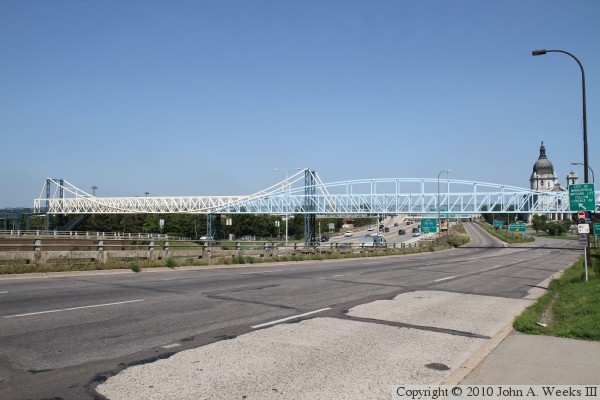
|
• Structure ID: |
NBI 27003 |
| • Bridge Carries: |
Pedestrian/Bicycle Path |
| • Bridge Crosses: |
Interstate I-94, Hennepin Avenue, Lyndale Avenue |
| • Bridge Type: |
Steel Through Truss w/Arch And Suspension Supports |
| • Length: |
387 Feet, 159 Foot Longest Span (See Notes Below) |
| • Width: |
12 Feet (Estimated) |
| • Height To Low Structure: |
29 Feet (Estimated) |
| • Date Built: |
1988 |
The Irene Hixon Whitney Bridge spans 17 lanes of busy street and interstate
highway to connect the Minneapolis Sculpture Garden with Loring Park just
west of downtown Minneapolis. Unlike the industrial style pedestrian bridges
built in the 1960s and 1970s, the Irene Hixon Whitney Bridge is a somewhat
whimsical structure that was designed to be a piece of artwork as well as
being a functional bridge. The result is one of the most recognizable
landmarks in the Twin Cities, one that is as fun as it is functional.
When the freeway system was built in the Twin Cities, it sliced the busy
wedge area near Hennepin and Lyndale avenue in two. It had long been desired
to tie these two areas of the city back together. An opportunity arose when
the city armory was tore down in the early 1980s, and the Minneapolis
Sculpture Garden was later expanded. The thought of making this bridge into
a functional sculpture was an obvious choice given that the west end of the
structure would land in the Minneapolis Sculpture Garden.
Minneapolis based artist Siah Armajani was commissioned to design this
structure. His philosophy is that all public buildings and bridges are
ornaments, so he was an excellent choice fore the project. The design
features two bridge styles that play a prominent role in Minneapolis
history. This includes the suspension bridge, such as the first bridge to
span the Mississippi, and the arch bridge, of which there are four
magnificent examples over the Mississippi River.
The bridge is named in honor of Irene Hixon Whitney. She was a lifelong
patron of the arts who had passed away in 1986 from lung cancer. She was
married to Wheelock Whitney Jr., who is an heir to the Northern States
Power fortune and a very successful businessman in his own right. Not only
was the Whitney family interested in art, but they also were responsible
for bringing the Twins, Vikings, and Northstars to the Twin Cities.
The National Bridge Inventory lists this bridge as 387 feet long. The guide
signs list 375 feet. My estimates from pacing the deck of the bridge and
from aerial photographs suggest that the bridge deck is 375 feet long. The
stairways extend beyond the end of the bridge deck on each end of the bridge.
If you include the stairways, the bridge is about 402 feet long. I have no
idea where the NBI came up with 387 feet.
Similarly, the NBI lists the longest span as being 159 feet. My estimates of
the three spans are 149 feet (suspension span on the west end of the bridge),
53 feet (span over southbound I-94), and 173 feet (arch span on the east end
of the bridge). Again, I have no idea where the 149 foot number may have
come from. I estimate the bridge deck being 12 feet wide, and the inside of
the truss structure being about 12 feet tall. Using that estimate, that
suggests that the low steel on the deck is about 29 feet above the lanes of
I-94, and the central bridge tower is about 58 feet tall (including its
concrete support base).
The photo above is looking northbound along Hennepin and Lyndale Avenue.
Interstate I-94 emerges from the Lowry Tunnel between the northbound and
southbound lanes of Hennepin and Lyndale Avenue. The bridge crosses over 3
lanes of Hennepin Avenue (northbound), 2 lanes of Lyndale Avenue (northbound),
8 lanes of I-94 (4 lanes northbound, 4 lanes southbound), and 4 lanes of
Hennepin Avenue and Lyndale Avenue (southbound).

These two photos are views looking west along the south face of the Irene
Hixon Whitney Bridge as seen from the bicycle ramp leading to the east end
of the structure. The Minneapolis Sculpture Garden is on the far end of
the bridge.
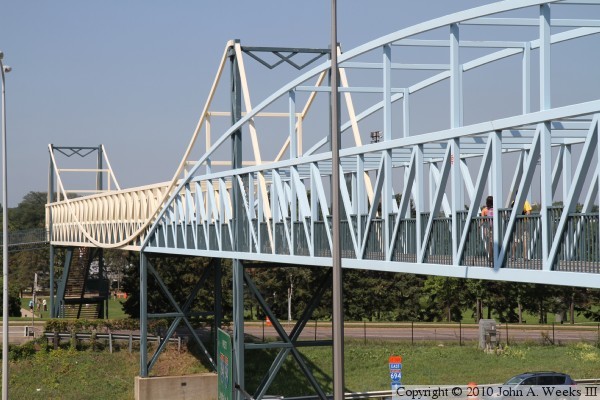

The photo above is looking northwest towards the south face of the Irene
Hixon Whitney Bridge. Interstate highway I-94 runs on the middle 8 lanes,
while Hennepin Avenue and Lyndale Avenue runs on the outer 9 lanes. The
photo below is a close view of the center bridge pier.
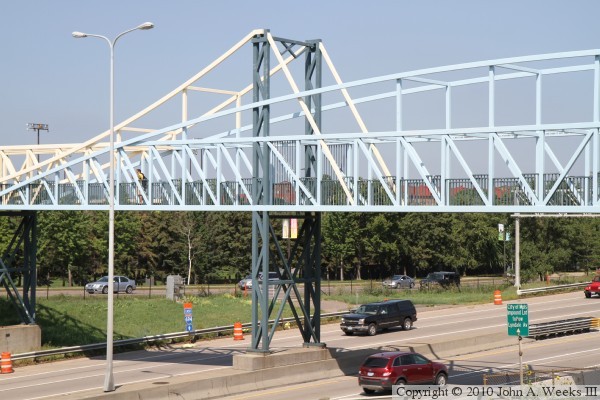
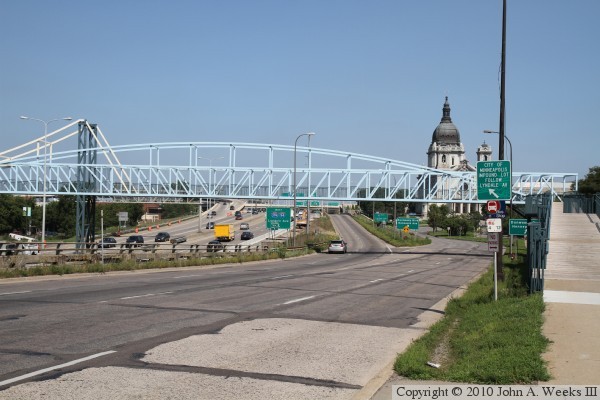
These two photos are additional views from the east side of Hennepin Avenue
looking towards the south face of the Irene Hixon Whitney Bridge. The photo
above features the blue arch span while the photo below features the yellow
suspension span.
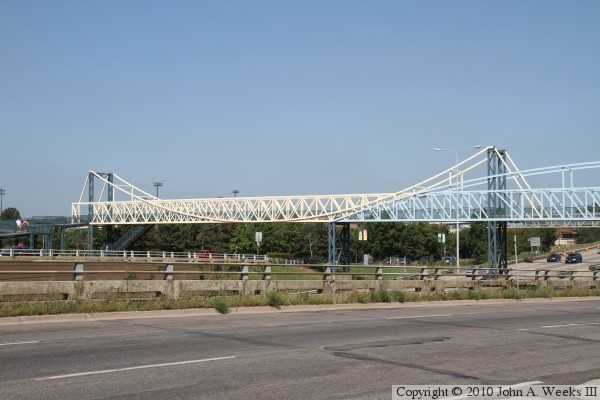
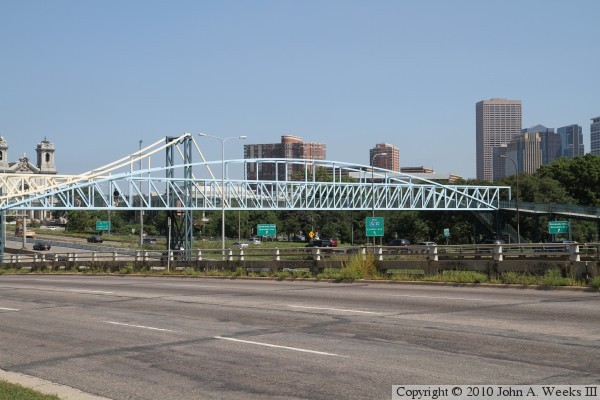
These two photos are views of the Irene Hixon Whitney Bridge from the west
side of the southbound lanes of Hennepin Avenue and Lyndale Avenue. The
photo above features the blue arch span while the photo below features the
yellow suspension span.
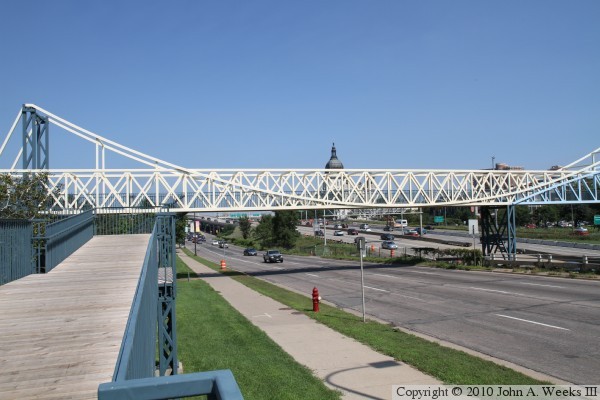
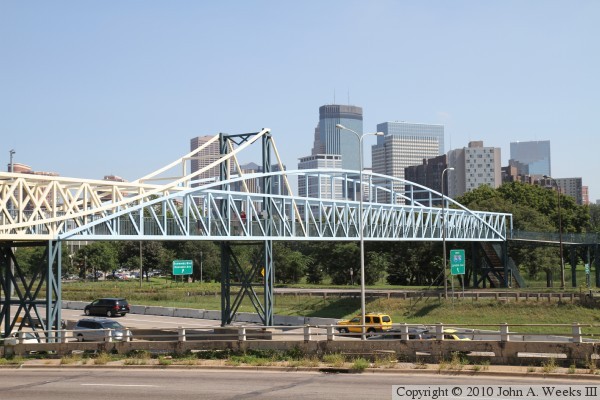
The photo above is a view looking northeast towards the blue arch bridge span.
This view features Loring Park and the Minneapolis city skyline in the
background. The photo below is a close view of the center bridge piers. The
shorter pier supports the west end of the arch structure while the taller
pier supports the east end of the suspension span.
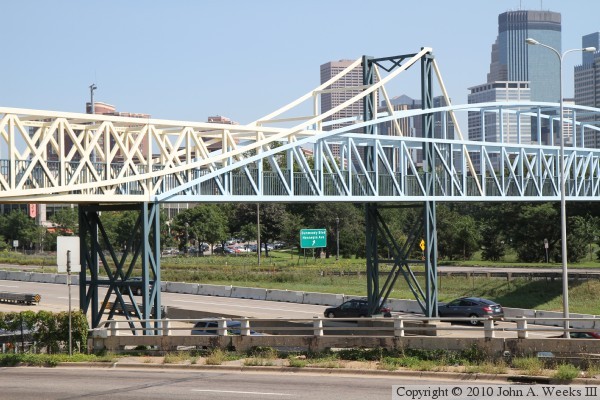
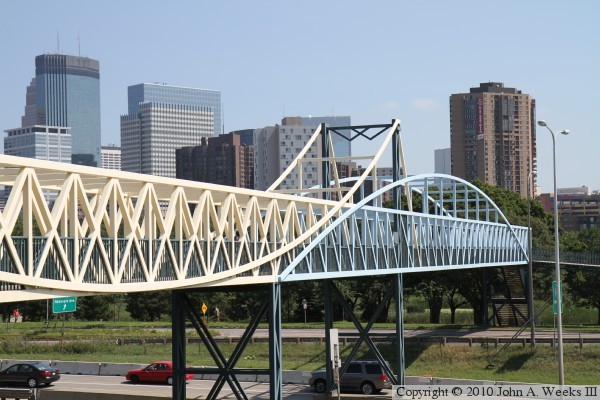
These two photos are views looking east along the south face of the Irene
Hixon Whitney Bridge as seen from the bicycle ramp leading to the west end
of the structure. Loring Park is in the background.


The photo above is the west end of the Irene Hixon Whitney Bridge.
Pedestrians can walk straight ahead and up the stairway, while bicycles can
use a ramp leading from the south. The photo below is a close view of the
steps leading to the bridge deck.
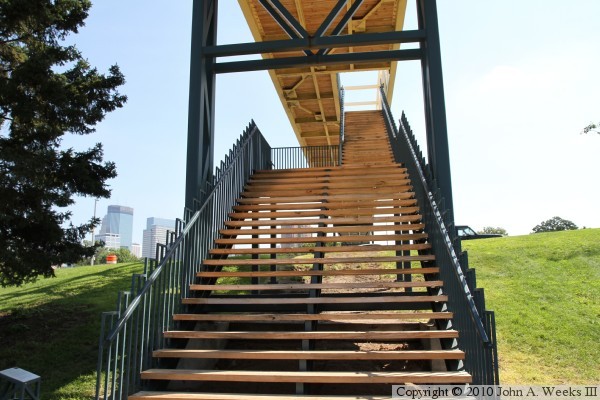

The photo above is looking west beyond the end of the bridge deck towards
the Minneapolis Sculpture Garden. The photo below is looking east down
the length of the bridge deck. The bridge deck is a long through truss
structure with a wooden deck. Note that the deck looks to be in very good
condition for a 22 year old structure. MN-DOT closed the bridge for 20 days
in May and June of 2010 to replace the deck and touch up the paint on the
structure.
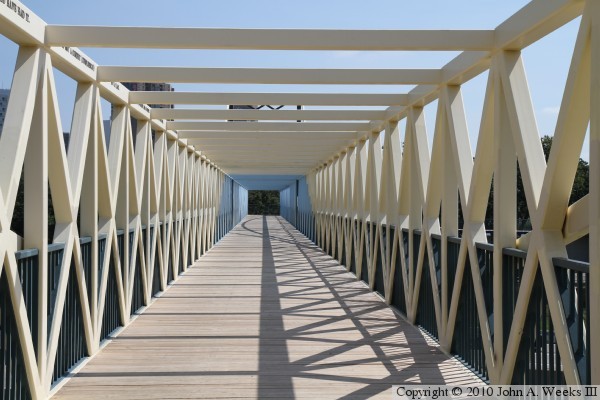
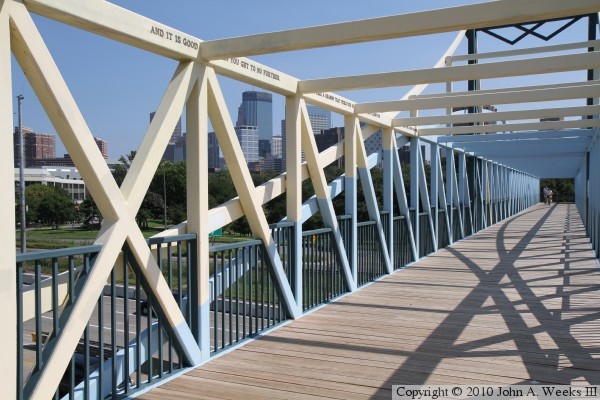
The photo above is looking northeast from inside the truss span at the
location where the suspension span transitions into the arch span. The
photo below is a similar view looking towards the taller pier that supports
the east end of the suspension span.
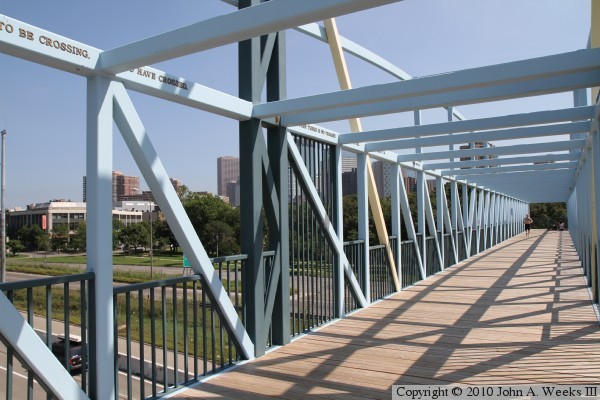
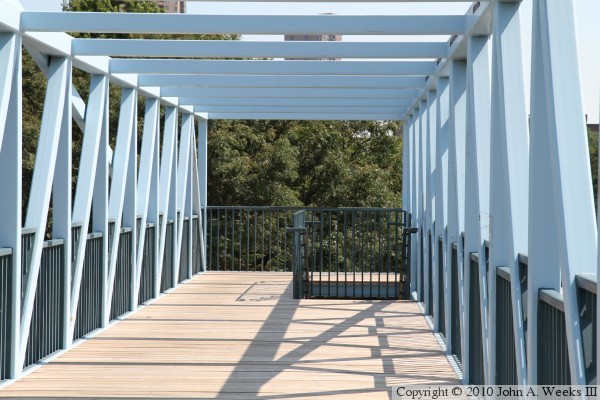
The photo above is looking east beyond the east end of the bridge deck and
into Loring Park. The photo below is looking down the stairway at the east
end of the bridge.
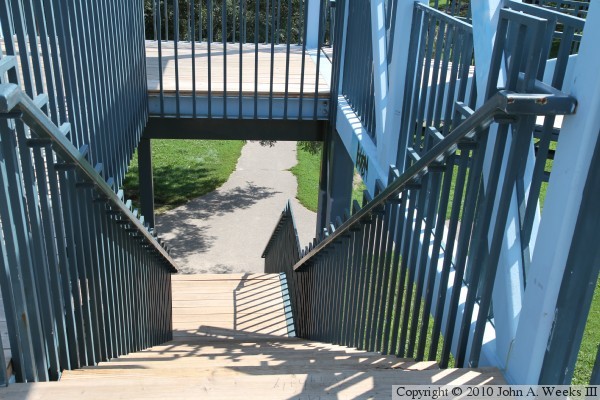
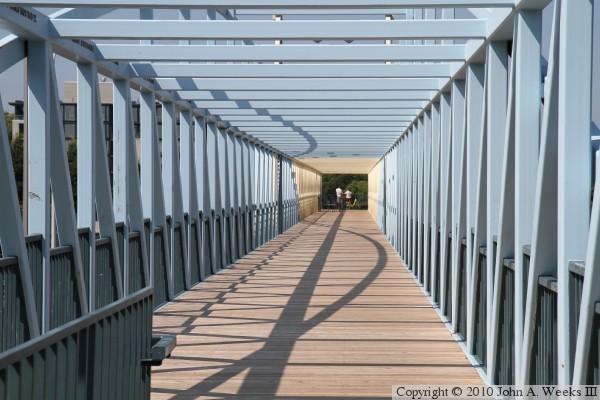
The photo above is looking west down the length of the bridge deck from the
east end of the structure. The photo below is a close view of the lettering
that runs along the inside of the north side of the bridge. The words are
from an untitled poem by John Ashbery.

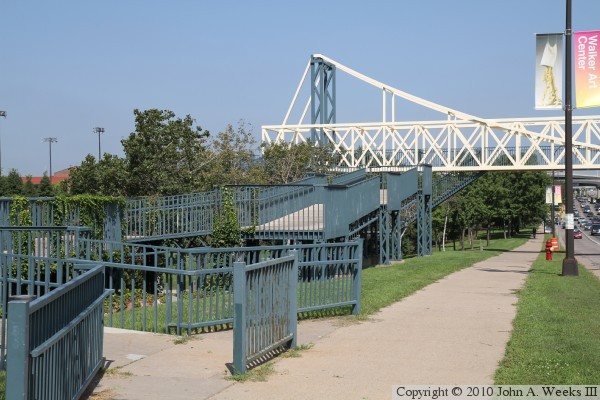
The photo above is the start of the bicycle ramp leading to the west end
of the Irene Hixon Whitney Bridge. The photo below is the south end of
this walkway structure. The walkway exits the street heading west, then
makes a sharp corner around a curved section.
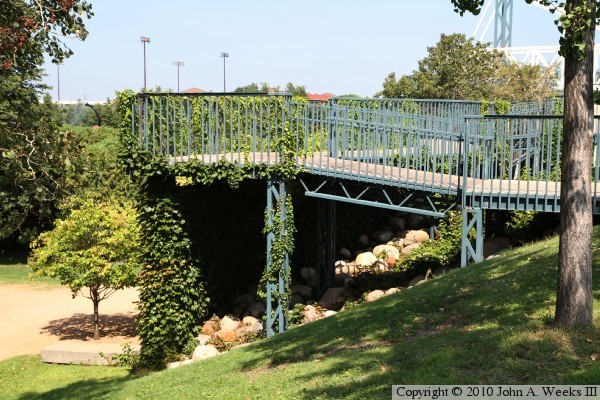
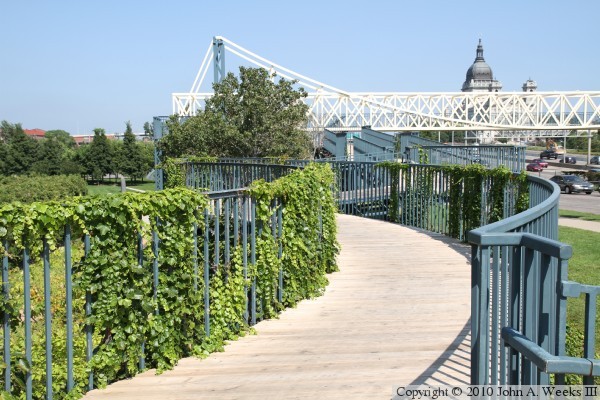
The photo above is the walkway in the curved section near the bottom of the
ramp. The photo above is the walkway as it climbs towards the bridge deck
level.
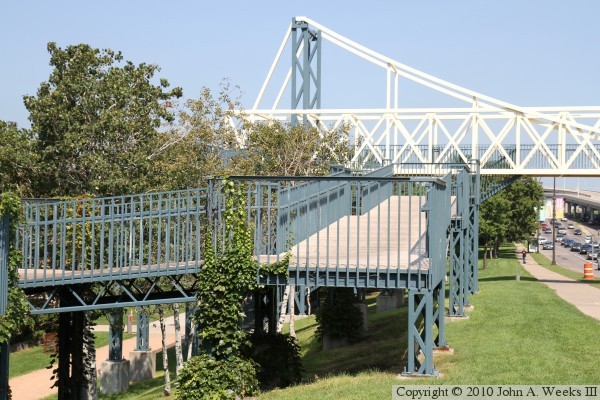

The photo above is a view of the walkway structure as seen from a trail
running through the Minneapolis Sculpture Garden. The photo below is a close
view of the west end of the bridge where the walkway attaches to the bridge
deck. The pier on the west end of the bridge supports the suspension span
on the west end of the structure.
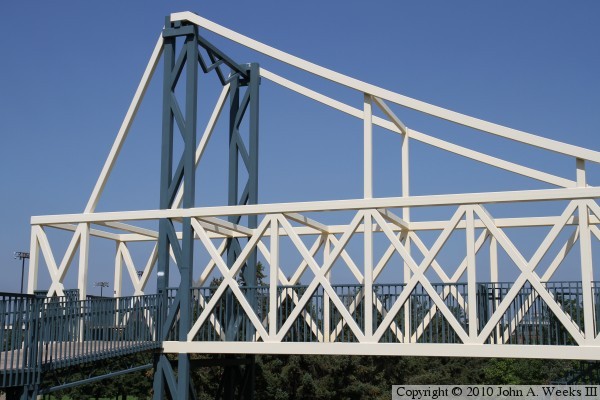
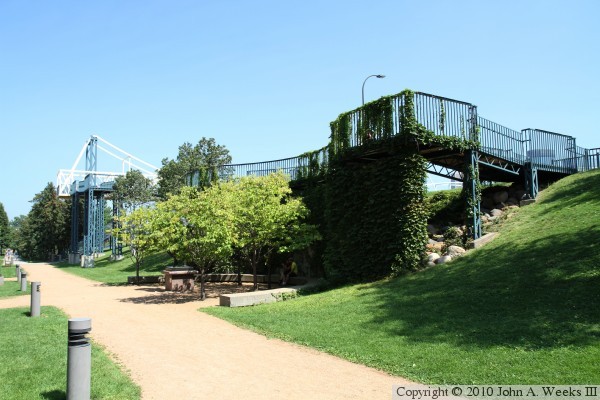
The photo above is a view of the curved section of walkway as seen from the
path running through the Minneapolis Sculpture Garden. The photo below
reveals the reason for the curved walkway. It is the display space for the
sculpture Prometheus Strangling the Vulture II by Jacques Lipchitz. This
work is a 1953 bronze casting based on a 1944 era piece.
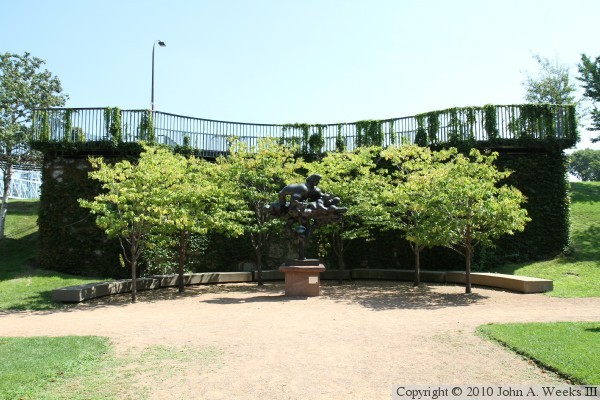
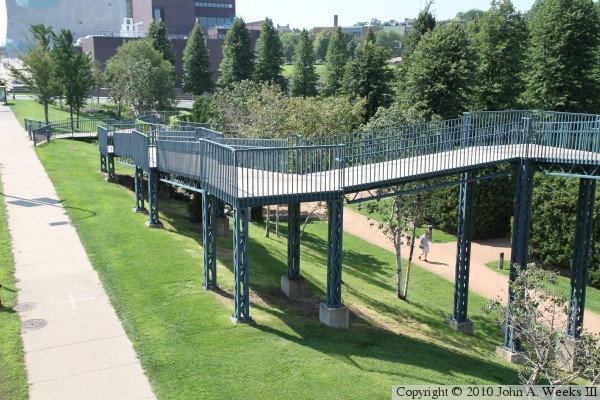
The photo above is looking south from the west end of the bridge deck towards
the walkway that leads down to Hennepin Avenue and Lyndale Avenue. The photo
below is a view of the structure under the bridge deck.
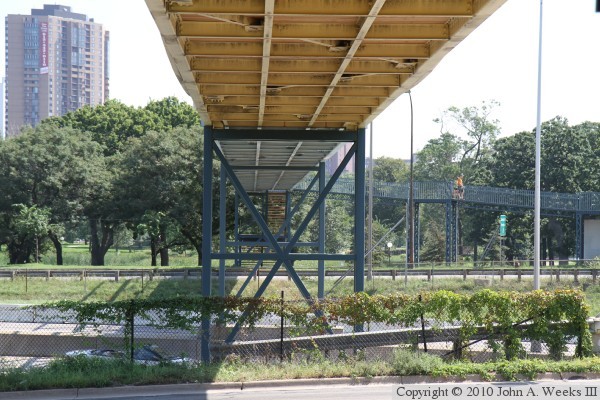
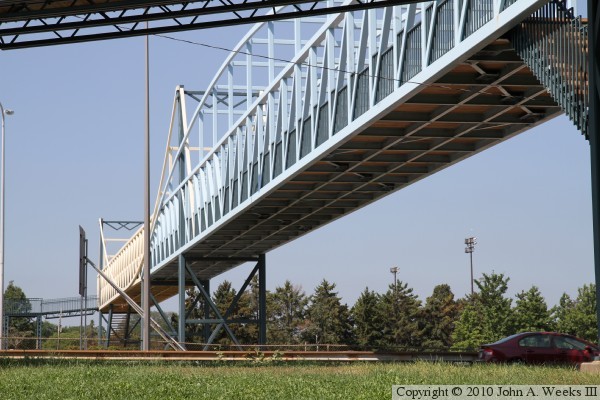
The photo above is looking west along the south face of the Irene Hixon
Whitney Bridge from ground level from a walking path in Loring Park. The
photo below is a view of the east end of the bridge structure and the
stairway that descends into Loring Park.

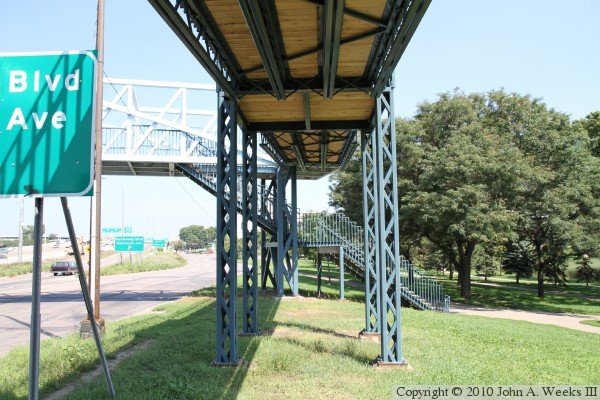
The photo above is a view looking north at the structure under the walkway
on the east end of the bridge. This photo is slightly over exposed to allow
the dark area under the bridge deck to show up a little better. The photo
below is a view of a curved section of walkway as seen from Loring Park.
The curved section matches a similar curved section that is used as gallery
space across the highway in the Minneapolis Sculpture Garden. On this side
of the highway, the curved section sports a mural. Designed and painted by
Joseph Barillaro in 1999, this monotone work looks much like graffiti, but is
far more organized and coherent.
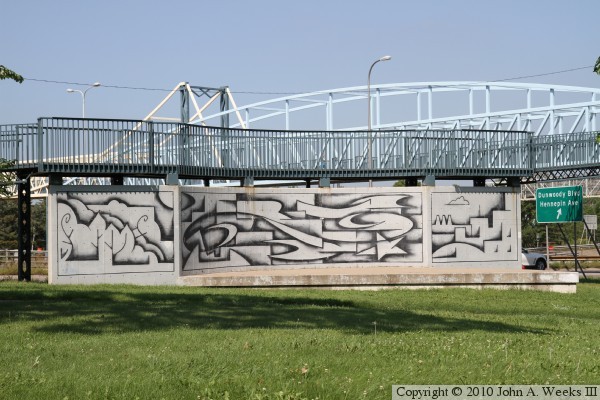
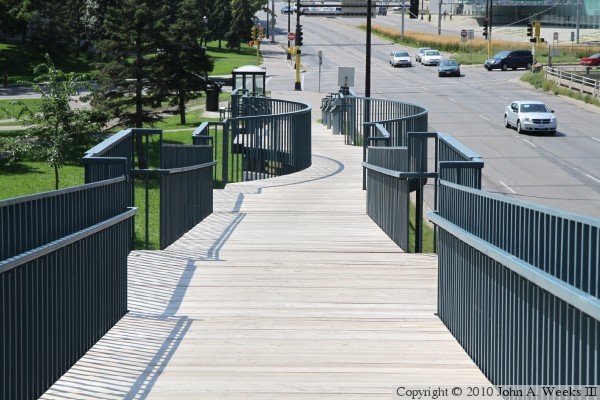
The photo above is a view looking south down the walkway leading to the east
end of the Irene Hixon Whitney Bridge. The photo below is a close view of
the structure that supports one of the flat and level sections of the walkway.
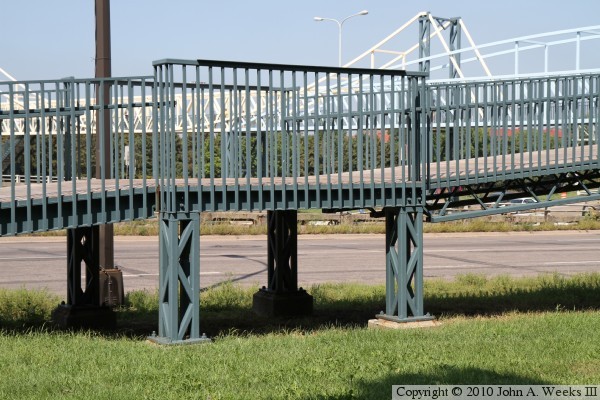
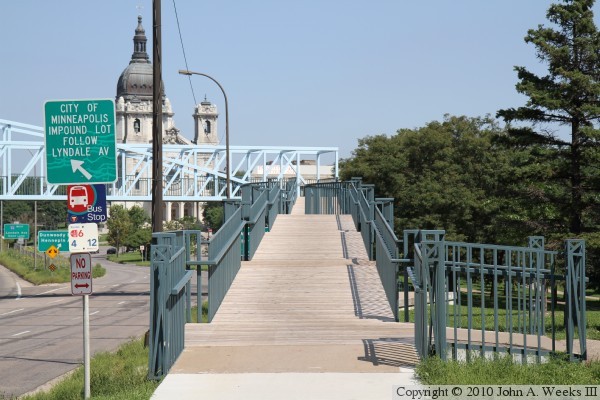
The photo above is looking north up the walkway ramp leading to the east end
of the Irene Hixon Whitney Bridge. This view would include a very nice view
of the Basilica of Saint Mary if it was not for the cluster of highway
signs partially blocking the sightlines. The photo below is a sign posted
near the entrance to the walkway.
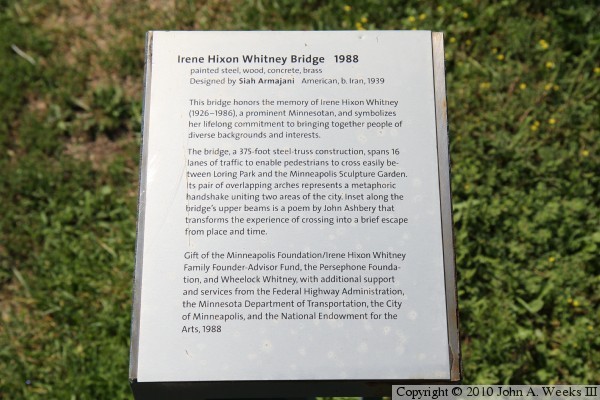
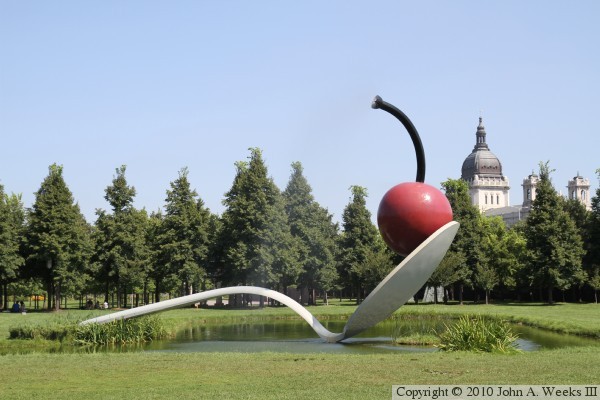
These two photos are two of the more famous sculptures in the Minneapolis
Sculpture Garden. The piece above is Spoonbridge and Cherry, a 1988 work
by Claes Oldenburg and Coosje Van Bruggen. Oldenburg is widely known for
his oversized depictions of everyday objects. The piece below is Hare on
Bell on Portland Stone Piers, a 1983 piece by Barry Flanagan. Flanagan was
known for using non-traditional materials in his works, which makes this use
of bronze, a very traditional sculpture material, all the more interesting.


The photo above is a view of the Minneapolis Sculpture Garden as seen from
the deck of the Irene Hixon Whitney Bridge. The large metal piece is called
Arikidea by Mark di Suvero. Despite being made out of heavy steel, the beams
are balanced in such a way that even the slightest breeze will make them
move. The photo below is a view of the blue arch span on the east end of
the bridge as seen from a vehicle traveling northbound on Lyndale Avenue.
The Basilica of Saint Mary is visible in the background.
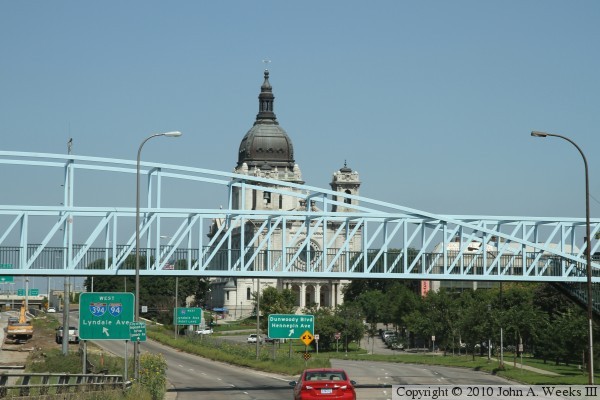
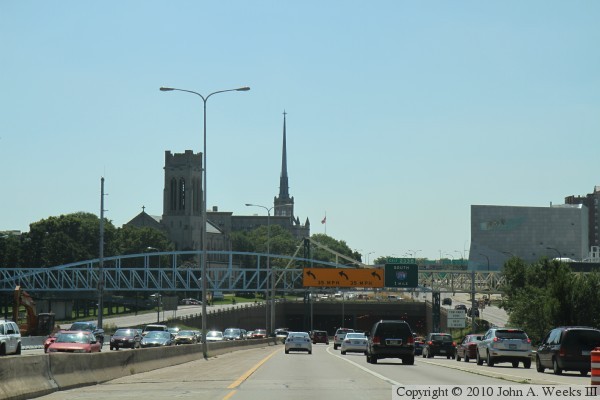
These two photos are views of the Irene Hixon Whitney Bridge as seen from
a vehicle traveling on Interstate I-94. The photo above is heading southbound
towards the north portal of the Lowry Tunnel. The southbound traffic lanes
pass between the two bridge piers in the middle of the span. The photo
below is a view heading northbound under the arch span just after emerging
from the Lowry Tunnel.

|















































